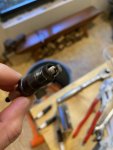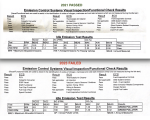turner
Member
- Joined
- Jul 21, 2021
- Messages
- 31
- Reaction score
- 13
- Points
- 8
- Location
- Santa Cruz, CA
- Vehicle Year
- 1987
- Make / Model
- Ford Ranger
- Engine Type
- 2.3 (4 Cylinder)
- Engine Size
- 2.3L
- Transmission
- Manual
- 2WD / 4WD
- 4WD
1987 2.3L 4x4 - I bought this in 2021 for cheap because the PO couldn't get it to pass smog. It was a "gross polluter", which in CA just means abnormally high HC/CO readings. This forum was a great resource then, I got it to pass without starting a thread. This time I'm a little more stumped, since I've so recently (2 years ago) addressed all the usual suspects.
Let's start with the test numbers. I passed very comfortably 2 years ago. And I failed miserably this past week. I was very surprised that in 2 years, and less than 3,000 miles, the emissions regressed so far.
2021
2023
Functional checks at smog station 2023:
What I've tried to date:
The smog checker is an experienced local mechanic. He told me to check the coolant temp sensor, that perhaps I was never leaving open loop mode. He was concerned that my dashboard temp gauge barely moved, but that's always been the case, and it passed with that condition. He also said it's running rich, and what I've read online suggests the same... rich running would fail both HC/CO. However, the plugs are chalky white, so it's not running rich. It's lean. I'm not sure what to make of that, or why he thought it was rich.
I absolutely flogged it up and down a mountain road before testing, but no idea how quickly the tech started my test. I've heard it only takes 10min for the cat to fall out of ideal heat range.
There are no vaccum leaks. I have not tested compression. I have not tested fuel pressure in 2023, but it was good in 2021. I have not tested the 02 sensor or cat, but they're both so new. The truck runs perfectly. No starting issues, no hesitation or stumbling or idle issues.
This is my daily driver, except I only drive once a week, and usually <2 miles. It might be in need of an italian tune-up, but surely that doesn't explain the huge increase in readings.
What else would you address before retesting?
Let's start with the test numbers. I passed very comfortably 2 years ago. And I failed miserably this past week. I was very surprised that in 2 years, and less than 3,000 miles, the emissions regressed so far.
2021
| HC (Max is 150/180) | CO (Max is 1.20/1.20) | |
| Idle | 11 | 0.00 |
| 2500 RPM | 11 | 0.00 |
2023
| HC (Max is 150/180) | CO (Max is 1.20/1.20) | |
| Idle | 3295 | 8.60 |
| 2500 RPM | 303 | 5.32 |
- PCV pass
- Cat pass
- EGR pass
- Fuel cap pass
- Spark controls pass
- Thermo air cleaner pass
- Vacuum lines pass
- Ignition timing pass
- Sensor wiring pass
- Evap controls pass
- Oxygen sensor pass
What I've tried to date:
- New TPS - 2021 (confirmed good/adjusted with voltmeter 2023)
- New MAP - 2021 & (again) 2023
- New PCV - 2021
- New dizzy rotor and cap - 2021
- New ignition wires - 2021
- Retimed ignition - 2021
- New cat - 2021
- New 02 sensor - 2021
- Seafoam treatment in fuel + top end - 2021 & 2023
- 10W-30 changed - 2021 & 2023
- Oil filter - 2021
- Air filter - 2021 & 2023
- Replaced coolant temp sensor - 2023
- New plugs - 2021 & 2023 (properly gapped)
- New air charge sensor - 2023 (old one was oily and bent, but bench tested good)
- Engine on/off EEC4 tests - no codes - 2023
The smog checker is an experienced local mechanic. He told me to check the coolant temp sensor, that perhaps I was never leaving open loop mode. He was concerned that my dashboard temp gauge barely moved, but that's always been the case, and it passed with that condition. He also said it's running rich, and what I've read online suggests the same... rich running would fail both HC/CO. However, the plugs are chalky white, so it's not running rich. It's lean. I'm not sure what to make of that, or why he thought it was rich.
I absolutely flogged it up and down a mountain road before testing, but no idea how quickly the tech started my test. I've heard it only takes 10min for the cat to fall out of ideal heat range.
There are no vaccum leaks. I have not tested compression. I have not tested fuel pressure in 2023, but it was good in 2021. I have not tested the 02 sensor or cat, but they're both so new. The truck runs perfectly. No starting issues, no hesitation or stumbling or idle issues.
This is my daily driver, except I only drive once a week, and usually <2 miles. It might be in need of an italian tune-up, but surely that doesn't explain the huge increase in readings.
What else would you address before retesting?
Last edited:
















